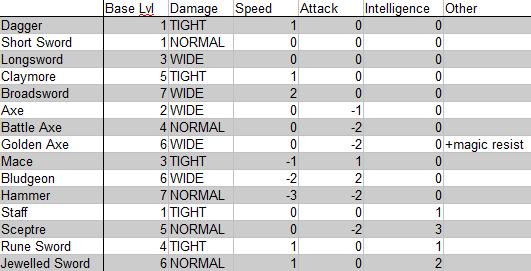I’m a huge believer in visualisation when it comes to system design. I’ll walk through some I’ve been doing over the past week and how it’s helped.
I recently doubled the number of items you can find in CQ2, using some sprites we had lying around (and filling in a few of the gaps). This led to a few issues. I mean, if you want ten items in any given category then you need them all to be unique, right? At the same time, if you use too many different statistics for items in a category, choosing between two items can involve 4 or 5 statistics more often than not. To avoid that I wanted to mostly stick within three core stats for each item category and two for weapons (since they have damage as well).
So it’s a matter of creating as much item diversity as possible with as little diversity as possible. That’s a job for a feature matrix!
I charted this stuff out to help me make sure all the stats get some love and that no two item categories are completely redundant in terms of the trade-offs they ask you to make. The results aren’t totally balanced – I’ve kept some quirks/redundancies just because they work thematically, like most armour providing defence and intelligence/faith/magic resist generally clustering together.
I then drilled down within each category with the same approach. Weapons were the messiest – there are 15 weapons now and that demanded careful attention to ensure they each felt unique.
I ended up splitting the weapons into four categories: swords, axes, maces and magic (which could overlap with any of the previous three) and assigning distinct stat effects to each group.
The cool thing about weapons is, no matter how weird their stats are, I can balance them by adjusting their damage. 😀 So I can load penalties onto some categories and it’s fine; they’ll just get higher damage to compensate.
There are two other things I can do to weapons to make them different – I can scale their damage based on their base level, and I can make their damage range tighter or wider than usual. So when I finally drill down to the weapons themselves it looks something like this:
And that’s it. I’ve taken some liberties against the above scheme with some especially dramatic individual weapons (like the Hammer and Golden Axe) to make them feel more special, and this doesn’t actually tell me each item’s exact statistics. But working from a reference damage for each base level, I can add or subtract damage to compensate for the stat boosts/penalties, adjust the range to make it wider or narrower, and finally tweak damage as necessary based on gut feel and feedback.
The end result of all this is that weapons feel distinct even when jammed into a fairly constrained possibility space, with only a few that are just a single stat point away from each other (again mostly due to thematic considerations like keeping starting weapons fairly simple).
Occasionally items can be boosted with random bonuses, but that’s perhaps something for another post!


